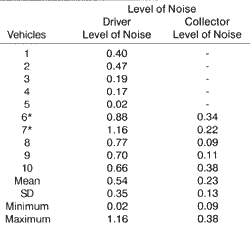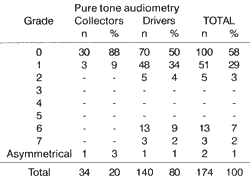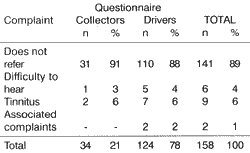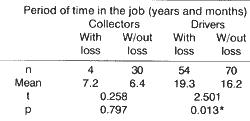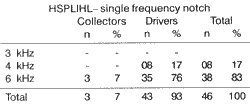

Year: 2001 Vol. 67 Ed. 4 - (4º)
Artigos Originais
Pages: 467 to 473
Hearing Loss in Bus Drivers and Ticket Collectors.
Author(s):
Adriana L. Martins*,
Katia F. Alvarenga**,
Maria C. Bevilacqua***,
Orozimbo A. Costa Filho****.
Keywords: hearing loss, noise, bus drivers
Abstract:
Aim: The present study evaluated the hearing of 174 employees of a bus company in Bauru, São Paulo, Brazil. Study design: Clinical prospective. Material and method: The study base consisted of two groups, comprising 140 drivers and 34 ticket collectors, ages ranging from 18 to 60 years. Sixteen subjects were excluded from the general analysis because they had risk factors for hearing loss and/or audiogram with configuration suggestive of other etiology associated with noise. They answered a short questionnaire and underwent pure tone audiometry. Noise level was measured in the work environment. Results: The results showed that the most frequent complaint among the surveyed group was tinnitus (6%). Conclusion: Noise-induced hearing loss was observed in 37% of the subjects and it was more frequent among drivers (34%) than ticket collectors (3%).
![]()
INTRODUCTION
The advance of technology provides better quality of life and well being to the society, in addition to harmful consequences, such as air and sound pollution. Noise and its noxious effects on physical health, especially hearing, have been the study topic of different research studies.
We are exposed to high levels of noise on a daily basis owing to the great concentration of vehicles in streets and avenues. Therefore, we tend to believe that noise in streets and avenues is as harmful as industrial noise, which is frequently addressed by studies.
Since last century, noise in large cities has been a topic of concern, and acts and regulations were enacted in an attempt to control urban noise17.
Studies have shown3,4,6,10,13 that initiatives in this arena were not successful, since noise in different cities has been increasing; some believe that continuous growth will lead to unhealthy levels of noise, probably increasing the incidence of hearing loss in the general population8,12,16. Based on data collected2 in a middle-sized city, vehicles are the main source of noise - buses in the top rank, followed by ambulances, trunks and motorcycles.
Therefore, similarly to other occupational settings in which noise is a key factor, hearing health of bus drivers and collectors should be considered, owing to the continuous exposure to noise produced by the bus engine and the other vehicles that comprise the busy traffic.
Nevertheless, the few references available in the literature addressed only the hearing skills of the drivers, probably because of the frontal position of the engine, and no studies addressed the hearing skills of ticket collectors, an occupation still common in a number of countries.
High sound pressure level induced hearing loss (HSPLIHL), according to the publication BRASIL-PORTARIA N° 19, DA SECRETARIA DE SEGURANC;A E SAUDE NO TRABALHO 5 -Administrative Act by the Labor Safety and Health Department, the terminology noise induced hearing loss should be replaced by high sound pressure level induced hearing loss (HSPLIHL). In the present study, we chose to use the acronym HSPLIHL (PAINPSE, in Portuguese), found in different studies conducted with this group of workers in Brazil1,15,18. That kind of loss was detected in studied bus drivers with an incidence ranging from 17% to 89% and defining correlation between hearing loss and time in the job and duration of exposure. Non-auditory symptoms have also been reported'. One study investigated hearing levels of collectors but concluded that they were less exposed to noise because of the position of the engine, which did not characterize potential risk to occupational deafness9.
Therefore, the purpose of the present study was to assess hearing levels of bus drivers and collectors from a company in Bauru, Sao Paulo in order to detect possible hearing impairment and to classify it.
MATERIAL AND METHOD
The present study was carried out in a private urban bus company located in the city of Bauru, São Paulo, whose population is approximately 300,000 inhabitants. Bus drivers and collectors worked on vehicles that had frontal, middle and rear engines and different degrees of maintenance and duration of use.
Criteria for selection of sample
First, we conducted anamnesis to collect data concerning otological history, main complaints, habits and general health status. Out of a total of 211 subjects, 37 were excluded from the study because they reported risk factors for hearing loss, divided into 14 collectors and 23 drivers. The risk factors reported were: 24 subjects worked in another noisy activity; six subjects, in activities exposed to chemicals and paint; five subjects were exposed to the association noise and chemical agent; and two had diabetes. The subjects included in the study reported that they did not engage in hobby or leisure activities that involved high levels of noise.
Next, we performed otoscopic inspection with otoscope brand MISSOURI, model TK, in order to ensure appropriate ear conditions for the conduction of pure tone audiometry.
There were two groups:
• collectors - subjects who had only worked in such activity;
• drivers - subjects who were working as drivers at that time.
Sample
There were 174 enrolled subjects in the study, 140 drivers and 34 collectors, all male subjects aged 18 to 60 years.
Procedures
Noise level measuring
In order to check the level of noise to which the workers were exposed during a normal day of work, we measured noise levels in some buses in two situations. First, with the dosimeter placed close to the driver, and then, close to the collector. We considered noise made by the engine, as well as the noise made by the passengers, the busy traffic, etc. We used the dosimeter brand Quest, model Micro 15, coupled to the body of the workers. We performed three measures in each selected bus, comprising a total of 10 buses. The noise was always measured at the driver's position and in five cases, at the collector's position as well. Buses were selected according to frequency of use and most common type of vehicles.
We used the analysis of daily noise exposure amount of noise to which a worker is exposed, expressed in percentage, taking as reference the maximum working hours in a day of work, and the maximum period considered for the definition of tolerance, that is, eight hours. According to NR-9 (1996)14 a non-harmful dose should not exceed 0.5% for a maximum workload of 8 hours.
Questionnaire
We employed a brief questionnaire including questions about daily workload and auditory complaint.
Pure tone audiometry and speech discrimination
According to BRASIL-PORTARIA N° 19, DA SECRETARIA DE SEGURANÇA E SAÚDE NO TRABALHO5, it is required to perform pure tone air conduction audiometry in frequencies 0.5, 1, 2, 3, 4, 6 and 8 kHz. If there are alterations at thresholds of frequencies 0.5, 1, 2, 3 and 4 kHz, bone conduction was also performed. We conducted speech reception thresholds (SRT) in all subjects to confirm pure tone thresholds.
We used audiometer brand INTERACOUSTICS, model AD 28, for the assessments conducted in a sound booth, employing daily biological calibration.
Criteria for the analysis of pure tone audiometry
In order to interpret and classify audiograms, we used the criteria proposed by BRASIL - PORTARIA N° 19, DA SECRETARIA DE SEGURANÇA E SAÚDE NO TRABALHO5 and MERLUZZI11:
• We considered thresholds within normal ranges for subjects whose audiograms were below 25dBHL, in all studied frequencies, classified as group O, or normal hearing;
• Subjects who had audiograms showing thresholds above 25dBHL in frequencies 3, and/or 4 and/or 6 KHz, worse than in other frequencies, either affected or not, both by air and bone conduction, unilateral or bilateral, were considered suggestive of HSPLIHL. These subjects were classified as groups 1, 2, 3, 4, and 5, according to severity, that is, first, second, third, fourth or fifth grades of hearing loss11.
• In groups 6 and 7 we included all audiograms, regardless of severity, whose curves indicated hearing deficit caused by some kind of mixed or sensorineural pathology, caused by a different etiology, associated or not with noise.
For the analysis, we included the asymmetrical item for subjects who presented bilateral sensorineural hearing loss, presenting different classification of severity for each ear in groups 1 to 5. Subjects in groups 6 and 7 did not receive the same classification.
Statistical analysis of data
We used Mann-Whitney test to compare the severity of hearing loss in the groups of drivers and collectors and t Student's test to define the correlation between hearing loss and duration of exposure for both groups. For correlation between duration of exposure and severity of hearing loss we used Spearman's correlation coefficient.
We adopted the significance level of 0.05 (a=5%). P values below this value were considered significant and represented by an asterisk (*).
RESULTS
Measurement of sound level
Table I shows the results of noise level measuring obtained in buses at driver and collector's positions.
Pure torte audiometry
Table 2 shows the analysis of pure tone audiometry in 174 subjects, following the criteria defined by BRASIL PORTARIA N° 19, DA SECRETARIA DE SEGURANÇA E SAÚDE NO TRABALHO5 and MERLUZZIII, for the group of drivers and collectors. It also shows the results of the statistical analysis conducted to compare the presence of HSPLIHL in the groups.
The data that follow exclude the subjects with grades 6 and 7 hearing loss, caused by other etiology rather than noise. Therefore, we analyzed the results collected from 158 subjects, 34 collectors and 124 drivers.
Table 3 presents the data from the questionnaire referring to presence of hearing loss, considering both studied groups.
The statistical study to analyze daily work load (daily exposure to noise) for both groups is presented in Table 4.
Table 5 presents the statistical study performed to compare the time in the job in both groups. The grade of HSPLIHL was studied statistically (Spearman's correlation coefficient), concerning time in the job for the groups of drivers and collectors (Table 6).
Table 7 described the statistical study performed for the analysis of age for both collectors and drivers.
Characterization of unilateral or bilateral HSPLIHL for the 58 subjects, is shown in Table 8. Analyses of HSPLIHL grade 1, with hearing loss notch for frequencies that were individually affected, considering number of ears, are described in Table 9.TABLE 1 - Results of noise level measurement in buses, using dosimeter positioned close to the driver and close to the ticket collector.
* articulated buses
TABLE 2 - Distribution of subjects according to classification of results from pure tone audiometry in 174 studied subjects and statistical analysis performed to compare occurrence of HSPLIHL among groups.
x² 10.27
p 0.001*
* p <- 0,05 - statistically significant.
TABLE 3 - Data obtained from questionnaire with the groups of collectors and drivers.
TABLE 4 - Results of statistical analysis conducted to analyze the daily working hours (duration of noise exposure) in the studied groups.
DISCUSSION
The noise level measurement demonstrated that drivers are exposed to noise levels higher than collectors, with values of 0.54 and 0.23, respectively (.Table 1). The noise level obtained at the driver's position was higher than the level considered non-harmful to workers' health, justifying preventive measures against hearing loss in this occupational segment. The same results were obtained in another study, in which only the drivers' health was analyzed, since they were the only ones whose health was jeopardized9.TABLE 5 - Comparison of mean period of time in the job (in years and months), among the groups with and without high sound pressure level induced hearing loss for the groups of collectors and drivers.
* p < 0,05 - statistically significant.
TABLE 6 - Results of the statistical analysis carried out to analyze the severity of high sound pressure level induced hearing loss considering time in the job, for the two studied groups.
* p < 0,05 - statistically significant.
TABLE 7 - Statistical analysis of age of subjects in the groups of collectors and drivers.
TABLE 8 - Classification of high sound pressure level induced hearing loss according to unilateral and bilateral affection.
In pure tone audiometry of 174 subjects we diagnosed 74 subjects (42% or 74/174) with sensorineural hearing loss, and 100, with normal hearing (58% or 100/ 174). Considering the group of collectors, 30 subjects (88% or 30/34) presented normal hearing and four of them (12% or 4/34), had hearing loss suggestive of HSPLIHL. For the group of drivers, 70 subjects (50% or 70/140) had normal hearing, 54 (39% or 54/140) had HSPLIHL suggestive loss, and 16 (11% or 16/140) had hearing loss suggestive of other cause, associated or not with noise, classified as grades 6 and 7 (Table 2). The incidence of HSPLIHL was higher among drivers (39%) than collectors (12%), with statistically significant difference, probable justified by the different levels of noise that the subjects are exposed (Table 2). However, it is important to emphasize that HSPLIHL was also observed among collectors, showing that preventive measures against hearing loss should involve both types of activities, and not only the drivers. If we analyze further the data collected from HSPLIHL, as shown in Table 2, considering only grades 1 and 2, grade 1 was the most frequent (29% or 51/174), followed by grade 2 (3% or 5/174). Grade 2 HSPLIHL was present only in the group of drivers.
Considering the group of 158 subjects, after exclusion of 16 subjects who had hearing loss suggestive of other pathologies, associated or not with noise, we found that in the questionnaire only 17 subjects (11% or 17/158) had some kind of hearing complaint. In the group of collectors, hearing complaint was noticed in three subjects (9% or 3/34) and in the group of drivers it was found in 14 subjects (12% or 14/124) (Table 3).
Difficulty to hear was reported by one subject (3% or 1/34) in the collectors group and in seven drivers (6% or 7/124), and two of them had associated tinnitus (2% or 2/124). Therefore, in both groups, there was an incompatibility between presence of hearing loss and complaint presented by subjects. This discrepancy may be due to the fact that the hearing losses detected fell within the category of grade 1 and few in grade 2, which do not interfere in the process of communication, considering the preservation of social hearing.TABLE 9 - Analysis of high sound pressure level induced hearing loss according to grade 1, with hearing loss and notch in single frequency, considering the number of ears for both studied groups.
As to tinnitus, it was present in two subjects (6% or 2/34) in the group of collectors and in seven subjects (6% or 7/124) in the group of drivers. We found that out of nine subjects with tinnitus, only two had associated hearing loss, showing that tinnitus sometimes is the only symptom found in subjects exposed to noise. We did not find any data that could have been compared to ours.
As to daily exposure to noise, both groups presented similar work load of 6:01 ± 0:08 and 6:14 ± 0:25, for the group of collectors and drivers, respectively (Table 4). However, the time in the job differed significantly, because the group of drivers, regardless of the presence of hearing loss, had worked longer than the collectors.
Considering the subjects with hearing loss, the mean time in the job for the group of collectors was 7.2 years and for the group of drivers, it was 19.3 years. Another important piece of data is that there was statistically significant difference in the group of drivers when we compared mean time in the job and presence or not of HSPLIHL (Table 5). Therefore, these findings demonstrated that time in the job is a factor that should be considered when analyzing the higher incidence of hearing loss in this group (Table 5). We also noticed a significant correlation between degree of hearing loss and time on the job of drivers (Table 6). The accumulative effect of noise was demonstrated in a previous study6. Another finding to be considered was older age of drivers, when compared to collectors (Table 7). The literature seems to agree that by the time the worker is retired, the action of noise should be considered together with presbyacusis.
According to Table 8, in the group of collectors HSPLIHL was characterized as unilateral in three subjects (75% or 3/4) and bilateral in one subject (25% or 1/4). For the group of drivers, in 31 subjects (57% or 31/54) HSPLIHL was unilateral and in 23 subjects (43% or 23/54) it was bilateral. In the two groups, the predominant hearing loss was unilateral, similarly affecting the right and left ears, since the position of the bus engine was variable.
In bilateral losses, there were two subjects with asymmetrical curves (1% or 2/58), one from the group of drivers and another from the collectors'.
Upon analyzing HSPLIHL grade 1, involving 51 subjects, 46 of them presented a notch in an individual frequency. The frequency of 6 KHz was the most frequently affected, involved in 38 subjects (83% or 38/ 46), followed by the frequency of 4 KHz, with a total of 8 subjects (17% or 8/46). The other frequencies were not individually affected, leading us to the conclusion that this type of noise affects initially the frequencies of 4 and 6 KHz, and the highest incidence was with the frequency of 6 KHz (Table 9).
CONCLUSIONS
The assessment of 174 subjects who worked as drivers and collectors in an urban bus company led us to the following conclusions:
• the occurrence of HSPLIHL was higher in the group of drivers (39%), when compared to the group of collectors (12%), with statistically significant difference;
• the level of noise measured at the driver's position was higher than the acceptable levels;
• the complaint of hearing loss was not common among subjects with HSPLIHL, since most of them presented grades 1 and 2 HSPLIHL, preserving social hearing;
• the main hearing complaint in the subjects with HSPLIHL was tinnitus;
• HSPLIHL was mainly characterized as unilateral;
• bilateral HSPLIHL was predominantly symmetrical;
• the level of noise at the driver's position, time in the job and work load presented statistically significant differences, which justified the higher incidence of HSPLIHL among drivers;
• the most frequently individually affected frequency was 6 KHz, followed by 4 KHz, and the other frequencies were not individually affected;
• preventive measures against hearing loss should be taken to protect both bus drivers and collectors.
REFERENCES
1. AHUMADA, H. T. & RAMIREZ, F. L. - Las condiciones de salud de los conductores de autotransportes urbanos de pasajeros de la ciudad de Mexico. Bol Oficina Sanit Panam, 111: 324-31, 1991.
2. ALVES JR., D. R. - Pesquisa aponta riscos no trabalho na Paulista. O Estado de São Paulo, 21 mar. 1997.
3. BENTO COELHO, J. L.; VALADAS, B; GUEDES, M. Ruído ambiente em Portugal. Rev. Acust. Vibr, 18: 17-31, 1996.
4. BERTOLLI, S., PAWA, C. E. - O transporte a sua poluição sonora. In: SIMPOSIO BRASILEIRO DE ACÚSTICA VEICULAR (SIBRAV), 4a, São Paulo, 1997. Anais. São Paulo, 1997. p. 61-66.
5. BRASIL. - Portaria n° 19 da Secretaria de Segurança e Saúde no Trabalho, publicada em 09 de abril de 1998, determina que o "exame audiométrico será executado por profissional habilitado, ou seja, medico ou fonoaudiológico". J. CFFa, 2: 4-5, 1998.
6. CARVALHO, M. J. M. - Poluição sonora no trânsito e no interior dos ônibus na cidade de Belo Horizonte. In: SIMPOSIO BRASILEIRO DE ACÚSTICA VEICULAR (SIBRAV), 4a, São Paulo, 1997. Anais. São Paulo, 1997. p. 43-8.
7. CORDEIRO, R.; LIMA FILHO, E. C.; NASCIMENTO, L. C. R. - Associação da perda auditiva induzida pelo ruído com tempo acumulado de trabalho entre motoristas e cobradores. Cad. Saúde Públ., 10: 210-21, 1994.
8. CALZOLARI CARMONA, G. R. - Influencia del ruido sobre la capacidad auditiva de los agentes de transito en la ciudad de Cordoba. Rev. Fac. Cienc. Md. Córdoba, 124, 1988.
9. FONSECA, C. J. - Avaliação da exposição ao ruído dos motoristas a cobradores de ônibus urbanos de São Paulo. São Paulo, FUNDACENTRO, 1993.
10. MARQUES, S. R. & RUSSO, I. C. E - A poluição sonora e a qualidade de vida nas grandes metrópoles. Rev. Bras. Fonoaud., 1: 3-5, 1997.
11. MERLUZZI, F.; PARIGI, G.; CORNACCHIA, L.; TERRANA, T. - Metodologia de execução do controle auditivo dos trabalhadores expostos a ruído. s.l., Assessoria de Higiene e Saúde da Região de Lombardia, 1979.
12. NEPOMUCENO, L. X. - Medidas técnicas para análise, avaliação a controle do barulho na indústria. Rev. Bras. Saúde Ocup., 7: 6-23, 1979.
13. NOGUEIRA, K. - Durma-se com todo esse barulho. Veja, 28: 12-8, 1995.
14. NR-9: atividades a operações insalubres. In: SEGURANO a medicina do trabalho. 32 ed. São Paulo, Atlas, 1996. p. 93-7. (Manuais de legislação Atlas, 16).
15. PATWARDHAN, M. S.; KOLATE, M. M.; MORE, T A. To assess effect of noise on hearing ability of bus drivers by audiometry. Indian J. Physiol. Pharmacol, 35: 35-8, 1991.
16. ROLLA, S. - Avaliação da poluição sonora na cidade de Campinas - SE In: CONGRESSO BRASIL-ARGENTINA E ENCONTRO DA SOCIEDADE BRASILEIRA DE ACÚSTICA (SOBRAC), 15°, Florianópolis, 1994. Anais. Florianópolis, 1994. p. 349-56.
17. STIELL, W C. - História dos transportes coletivos em São Paulo. Editora da USE, Ed. Mc Graw-Hill do Brasil, 1978.
18. TALAMINI, M. E. -A perda auditiva induzida por ruído em motoristas de ônibus. Tuiuti. Cienc. Cult., 2: 41-56, 1994.
* Specialist in Clinical Audiology and Rehabilitation, Fundação para Estudo a Tratamento das Deformidades Craniofaciais (FUNCRAF), Hospital de Reabilitação de Anomalias Craniofaciais, Universidade de São Paulo (HRAC-USP), Bauru/SP
** Ph.D. in Human Communication Disorders, Universidade Federal de São Paulo (EPM), Professor at the School of Speech and Hearing Pathology, Faculdade de Odontologia de Bauru, Universidade de São Paulo (FOB-USP), Bauru/SE
*** Speech and Hearing Pathologist, HRAGUSP, Full Professor, School of Speech and Hearing Pathology, FOB-USP, Bauru/SP
**** Physician, HRAC-USP, Full Professor, School of Speech and Hearing Pathology, FOB-USP, Bauru/SE
Affiliation: Centro de Pesquisas Audiológicas do Hospital de Reabilitação de Anomalias Craniofaciais, Universidade de São Paulo, Bauru-SP
Financial Support: Fundação de Amparo a Pesquisa do Estado de São Paulo (FAPESP).
Address correspondence to: Adriana L. Martins - Rua Machado de Assis, 16-33 - Bauru/SP - Tel: (55 14) 223-5532.
Article submitted on January 11, 2001. Article accepted on April 20, 2001.
